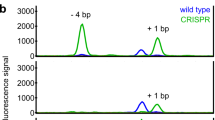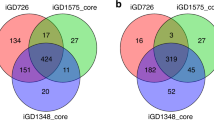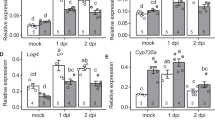Abstract
ROBERTSON et al.1,2 proposed that plant enzymes rather than bacteroid enzymes are physiologically important in the assimilation of the ammonia produced after nitrogen reduction in the bacteroids of leguminous nodules. They demonstrated that during the development of the nodule, glutamine synthetase (EC 6.3.1.2, equation (1)) and glutamate synthase(EC 2.6.1.53, equation (2)) activity increased considerably in the plant fraction but not in the bacteroid fraction of the nodule, parallel with the induction of nitrogenase and leghaemoglobin.But, the predominant amino acid transported in the xylem of lupins and many other legumes is asparagine2–4. Robertson et al.2 suggested therefore that asparagine was most probably synthesised in the plant fraction of the nodule by a glutamine-dependent asparagine synthetase5,6 (EC 6.3.5.4, equation (3)) rather than in the bacteroids, which might utilise for asparagine biosynthesis an ammonium-dependent asparagine synthetase (EC 6.3.1.1, equation (4)), which has been reported to occur in other prokaryotes7.
This is a preview of subscription content, access via your institution
Access options
Subscribe to this journal
Receive 51 print issues and online access
$199.00 per year
only $3.90 per issue
Buy this article
- Purchase on Springer Link
- Instant access to full article PDF
Prices may be subject to local taxes which are calculated during checkout
Similar content being viewed by others
References
Robertson, J. G., Farnden, K. J. F., Warburton, M. P., and Banks, J. M., Aust. J. Pl. Physiol., 2, 265–272 (1975).
Robertson, J. G., Warburton, M. P., and Farnden, K. J. F., FEBS Lett., 55, 33–37 (1975).
Pate, J. S., Gunning, B. E. S., and Briarty, L. G., Planta, 85, 11–34 (1969).
Streeter, J. G., Agron. J., 64, 311–314 (1972).
Rognes, S. E., FEBS Lett., 10, 62–66 (1970).
Streeter, J. G., Archs Biochem. Biophys., 157, 613–624 (1973).
Cedar, H., and Schwartz, J. H., J. biol. Chem., 244, 4112–4121 (1969).
Rognes, S. E., Phytochemistry, 14, 1975–1982 (1975).
Jackson, R. C., and Handscriumacher, R. E., Biochemistry, 9, 3585–3590 (1970).
Atkins, C. A., Pate, J. S., and Sharkey, P. J., Pl. Physiol., Lancaster, 56, 807–812 (1975).
Kurz, W. G. W., Rokosh, D. A., and LaRue, T. A., Can. J. Microbiol., 21, 1009–1012 (1975).
Brown, C. M., and Dilworth, M. J., J. gen. Microbiol., 86, 39–48 (1975).
O'Neal, D., and Joy, K. W., Pl. Physiol., Lancaster, 54, 773–779 (1974).
Scholander, P. F., Hammel, H. T., Hemmingsen, E. A., and Bradstreet, E. D., Proc. natn. Acad Sci. U.S.A., 52, 119–125 (1964).
Author information
Authors and Affiliations
Rights and permissions
About this article
Cite this article
SCOTT, D., FARNDEN, K. & ROBERTSON, J. Ammonia assimilation in lupin nodules. Nature 263, 703–705 (1976). https://doi.org/10.1038/263703a0
Received:
Accepted:
Published:
Issue Date:
DOI: https://doi.org/10.1038/263703a0
This article is cited by
-
Molecular cloning and characterisation of asparagine synthetase from Lotus japonicus: Dynamics of asparagine synthesis in N-sufficient conditions
Plant Molecular Biology (1996)
-
A system for tissue-specific copper-controllable gene expression in transgenic plants: Nodule-specific antisense of asparate aminotransferase-P2
Transgenic Research (1996)
-
Repression of the L-asparaginase gene during nodule development in Lupinus angustifolius
Plant Molecular Biology (1994)
-
Expression and regulation of the Escherichia coli glutamate dehydrogenase gene (gdh) in Rhizobium japonicum
Archives of Microbiology (1986)
Comments
By submitting a comment you agree to abide by our Terms and Community Guidelines. If you find something abusive or that does not comply with our terms or guidelines please flag it as inappropriate.



